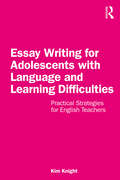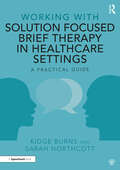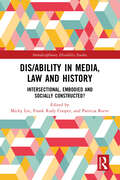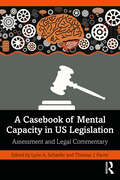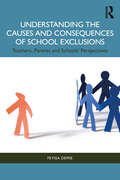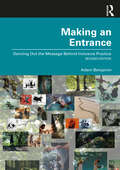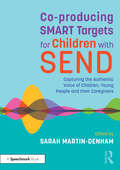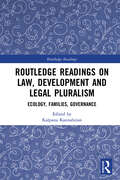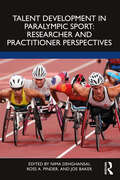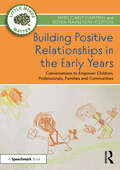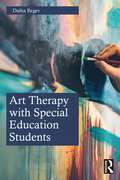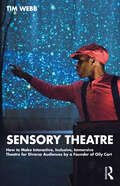- Table View
- List View
Essay Writing for Adolescents with Language and Learning Difficulties: Practical Strategies for English Teachers
by Kim KnightEssay Writing for Adolescents with Language and Learning Difficulties is a step-by-step guide for educators teaching secondary students with language difficulties how to write an English essay and, more importantly, how to do this on their own. Essay writing is one of the most difficult skills that secondary school students need to develop, though there are limited resources available to support these students and their teachers. Based on research into language disorders in adolescence and language processing, the strategies in this book are easy to apply and represent a scaffolded and sequenced approach to teaching essay writing. The book's structure encourages students' skills and confidence to be developed gradually, each chapter building on the last, beginning with the early stages of text analysis and progressing through to writing a complete essay. While written with students with language difficulties in mind, the strategies in this book are applicable to teaching all secondary school students. Written by a speech pathologist with over a decade’s experience working in secondary schools, this book is an essential resource for all high school English teachers and any education professionals responsible for teaching adolescents how to write essays competently and confidently.
Working with Solution Focused Brief Therapy in Healthcare Settings: A Practical Guide (Working With)
by Kidge Burns Sarah NorthcottSolution focused brief therapy is an evidence-based approach that enables people to make meaningful change in their everyday lives. This book shares ideas on how speech and language therapists and others working in medical settings can integrate SFBT into their therapeutic interactions to support clients handling acute or chronic health conditions. It outlines core aspects of the approach in an accessible format, bridging the gap between theory and practice, and provides guidance on adapting SFBT for clients living with communication disabilities. There are suggestions for different clinical situations, with real-life case examples drawn from working with people living with Parkinson’s disease, stroke, motor neurone disease, cancer and chronic pain. Combining practical advice with photocopiable resources, this book covers: • Establishing person-centred, holistic goals for therapy • Future focused descriptions • Building on a person’s resources and successes • Responding to distress • Supervision and support This accessible book can be read as an introductory text for those new to this approach and will also be invaluable to clinicians who have already received some training in SFBT. It is likely to become a trusted resource, supporting allied health professionals and others to ensure their therapy is grounded in client priorities.
Working with Solution Focused Brief Therapy in Healthcare Settings: A Practical Guide (Working With)
by Kidge Burns Sarah NorthcottSolution focused brief therapy is an evidence-based approach that enables people to make meaningful change in their everyday lives. This book shares ideas on how speech and language therapists and others working in medical settings can integrate SFBT into their therapeutic interactions to support clients handling acute or chronic health conditions. It outlines core aspects of the approach in an accessible format, bridging the gap between theory and practice, and provides guidance on adapting SFBT for clients living with communication disabilities. There are suggestions for different clinical situations, with real-life case examples drawn from working with people living with Parkinson’s disease, stroke, motor neurone disease, cancer and chronic pain. Combining practical advice with photocopiable resources, this book covers: • Establishing person-centred, holistic goals for therapy • Future focused descriptions • Building on a person’s resources and successes • Responding to distress • Supervision and support This accessible book can be read as an introductory text for those new to this approach and will also be invaluable to clinicians who have already received some training in SFBT. It is likely to become a trusted resource, supporting allied health professionals and others to ensure their therapy is grounded in client priorities.
Let's Go Shopping: A Grammar Tales Book to Support Grammar and Language Development in Children (Grammar Tales)
by Jessica HabibPete and Jem are very helpful at the supermarket, but end up causing chaos with a tower of food on display. Targeting Subject-Verb-Object sentences and the conjunction ‘and’ for listing, this book provides repeated examples of early developing syntax and morphology which will engage and excite the reader while building pre-literacy skills and make learning fun, as well as exposing children to multiple models of the target grammar form. Perfect for a speech and language therapy session, this book is an ideal starting point for targeting client goals and can also be enjoyed at school or home to reinforce what has been taught in the therapy session.
Let's Go Shopping: A Grammar Tales Book to Support Grammar and Language Development in Children (Grammar Tales)
by Jessica HabibPete and Jem are very helpful at the supermarket, but end up causing chaos with a tower of food on display. Targeting Subject-Verb-Object sentences and the conjunction ‘and’ for listing, this book provides repeated examples of early developing syntax and morphology which will engage and excite the reader while building pre-literacy skills and make learning fun, as well as exposing children to multiple models of the target grammar form. Perfect for a speech and language therapy session, this book is an ideal starting point for targeting client goals and can also be enjoyed at school or home to reinforce what has been taught in the therapy session.
Dis/ability in Media, Law and History: Intersectional, Embodied AND Socially Constructed? (Interdisciplinary Disability Studies)
by Micky Lee Frank Rudy Cooper Patricia ReeveThis book explores how being "disabled" originates in the physical world, social representations and rules, and historical power relations—the interplay of which render bodies "normal" or not. Do parking signs that represent people in wheelchairs as self-propelling influence how we view dis/ability? How do wheelchair users understand their own bodies and an environment not built for them? By asking questions like these the authors reveal how normalization has informed people’s experiences of their bodies and their fight for substantive equality. Understanding these processes requires acknowledging the tension between social construction and embodiment as well as centering the intersection of dis/abilities with other identities, such as race, class, gender, sex orientation, citizen status, and so on. Scholars and researchers will find that this book provides new avenues for thinking about dis/ability. A wider audience will find it accessible and informative.
Dis/ability in Media, Law and History: Intersectional, Embodied AND Socially Constructed? (Interdisciplinary Disability Studies)
by Micky LeeThis book explores how being "disabled" originates in the physical world, social representations and rules, and historical power relations—the interplay of which render bodies "normal" or not. Do parking signs that represent people in wheelchairs as self-propelling influence how we view dis/ability? How do wheelchair users understand their own bodies and an environment not built for them? By asking questions like these the authors reveal how normalization has informed people’s experiences of their bodies and their fight for substantive equality. Understanding these processes requires acknowledging the tension between social construction and embodiment as well as centering the intersection of dis/abilities with other identities, such as race, class, gender, sex orientation, citizen status, and so on. Scholars and researchers will find that this book provides new avenues for thinking about dis/ability. A wider audience will find it accessible and informative.
A Casebook of Mental Capacity in US Legislation: Assessment and Legal Commentary
by Lynn A. Schaefer Thomas J. FarrerA Casebook of Mental Capacity in US Legislation: Assessment and Legal Commentary employs an applied and accessible approach to the assessment of mental capacity. Through the use of rich vignettes and case examples, the text provides legal commentary to illustrate state laws and ethical principles from varied decision-making capacities in distinct settings to fortify its assessment. The text begins by providing a background about decision-making capacity as a construct. It also provides practical guidance on capacity assessment germane to a broad range of clinical settings, including geropsychology, health psychology, and neuropsychology. It moves on to reviewing decision-making rights that make up capacity, and provides ethical guidelines while drawing the practitioner’s attention to the common pitfalls. The case presentations and legal commentary underline key areas such as the capacity to consent to medical treatment, make welfare decisions, enter into a sexual relationship, make financial decisions, create or revoke a will, litigate and contract, and stand trial. It also includes a chapter focusing on integrating culture and diversity in capacity evaluations with the aim of increasing the practitioner’s competence. This casebook will be useful for clinical psychologists in practice, researchers and students seeking to understand how to perform capacity assessments, as well as other related healthcare professionals. It is further aimed at legal professionals to utilize as a reference that details how individual types of capacity are defined and assessed.
A Casebook of Mental Capacity in US Legislation: Assessment and Legal Commentary
by Lynn A. Schaefer Thomas J. FarrerA Casebook of Mental Capacity in US Legislation: Assessment and Legal Commentary employs an applied and accessible approach to the assessment of mental capacity. Through the use of rich vignettes and case examples, the text provides legal commentary to illustrate state laws and ethical principles from varied decision-making capacities in distinct settings to fortify its assessment. The text begins by providing a background about decision-making capacity as a construct. It also provides practical guidance on capacity assessment germane to a broad range of clinical settings, including geropsychology, health psychology, and neuropsychology. It moves on to reviewing decision-making rights that make up capacity, and provides ethical guidelines while drawing the practitioner’s attention to the common pitfalls. The case presentations and legal commentary underline key areas such as the capacity to consent to medical treatment, make welfare decisions, enter into a sexual relationship, make financial decisions, create or revoke a will, litigate and contract, and stand trial. It also includes a chapter focusing on integrating culture and diversity in capacity evaluations with the aim of increasing the practitioner’s competence. This casebook will be useful for clinical psychologists in practice, researchers and students seeking to understand how to perform capacity assessments, as well as other related healthcare professionals. It is further aimed at legal professionals to utilize as a reference that details how individual types of capacity are defined and assessed.
Understanding the Causes and Consequences of School Exclusions: Teachers, Parents and Schools' Perspectives
by Feyisa DemieThis book outlines a study of the causes and consequences of school exclusions. It explores the experiences of schools, teachers, parents, and governors and includes a focus on the experience of Black and minority ethnic students and those with special educational needs and disabilities. The book presents the results of detailed empirical research from English schools that studied teachers, school leaders, parents, governors, educational psychologists, and school staff experience with school exclusions. The book examines the scale of the problem and underlying factors, the disproportionality of exclusions for SEND and minority ethnic students, comparative international literature on exclusions and implications for policy, practice, and research. Providing a comprehensive overview of the factors affecting school exclusions, the book will be of great interest to researchers, academics, and students in the areas of education policy, inclusion and special education needs in education. It will also be of interest to policy makers and education professionals including special educational needs co-ordinators and headteachers.
Understanding the Causes and Consequences of School Exclusions: Teachers, Parents and Schools' Perspectives
by Feyisa DemieThis book outlines a study of the causes and consequences of school exclusions. It explores the experiences of schools, teachers, parents, and governors and includes a focus on the experience of Black and minority ethnic students and those with special educational needs and disabilities. The book presents the results of detailed empirical research from English schools that studied teachers, school leaders, parents, governors, educational psychologists, and school staff experience with school exclusions. The book examines the scale of the problem and underlying factors, the disproportionality of exclusions for SEND and minority ethnic students, comparative international literature on exclusions and implications for policy, practice, and research. Providing a comprehensive overview of the factors affecting school exclusions, the book will be of great interest to researchers, academics, and students in the areas of education policy, inclusion and special education needs in education. It will also be of interest to policy makers and education professionals including special educational needs co-ordinators and headteachers.
Making an Entrance: Dancing Out the Message Behind Inclusive Practice
by Adam BenjaminThis second edition of Making an Entrance is a practical and thought-provoking introduction to teaching dance with disabled and non-disabled students, updated with expanded coverage, new and revised exercises, and chapters that cover post-pandemic and online practice, diversity and inclusivity. With improvisation as his central concern Benjamin covers an extensive range of topics, including new autoethnographic writing, mental health, performance, feedback, and The Dancers’ Forest, and interrogates what we mean when we talk about ‘inclusive’ and ‘integrated dance.’ There are over 50 stimulating and challenging exercises purposefully designed for dance students of all levels accompanied by teaching notes, and examples drawn from the author’s experience as a teacher, performer, and dance maker. Useful hints are provided on the practicalities of setting up workshops covering issues such as class sizes, the safety aspects of wheelchairs and accessibility. An essential read for both students and teachers of improvisation who are seeking ways to engage with issues of diversity, written to be accessible whilst offering areas of increasing complexity and challenge for more experienced practitioners.
Making an Entrance: Dancing Out the Message Behind Inclusive Practice
by Adam BenjaminThis second edition of Making an Entrance is a practical and thought-provoking introduction to teaching dance with disabled and non-disabled students, updated with expanded coverage, new and revised exercises, and chapters that cover post-pandemic and online practice, diversity and inclusivity. With improvisation as his central concern Benjamin covers an extensive range of topics, including new autoethnographic writing, mental health, performance, feedback, and The Dancers’ Forest, and interrogates what we mean when we talk about ‘inclusive’ and ‘integrated dance.’ There are over 50 stimulating and challenging exercises purposefully designed for dance students of all levels accompanied by teaching notes, and examples drawn from the author’s experience as a teacher, performer, and dance maker. Useful hints are provided on the practicalities of setting up workshops covering issues such as class sizes, the safety aspects of wheelchairs and accessibility. An essential read for both students and teachers of improvisation who are seeking ways to engage with issues of diversity, written to be accessible whilst offering areas of increasing complexity and challenge for more experienced practitioners.
Co-producing SMART Targets for Children with SEND: Capturing the Authentic Voice of Children, Young People and their Caregivers
by Sarah Martin-DenhamThis accessible guide supports school and education settings in co-producing SMART targets for education health and care plans, SEN support plans and Personal Education Plans. The book encourages educators to collaborate with children, young people and their caregivers to gain an in-depth understanding of their views, aspirations, strengths and areas of challenge, and to write purposeful, specific, measurable and achievable targets. Each chapter offers successful approaches to capture authentic voice, with a variety of contributors sharing their journey to improve child and family leadership by developing child-centred approaches in their contexts. The book includes case studies and reflective activities to further support the reader with creative and innovative approaches to SMART targets that are underpinned by the child's perspective. With contributions from a range of schools, and across age phases, this book encourages and enables collaboration with children, young people and their caregivers, and will be essential reading for SENCOs, designated leads for safeguarding, teachers and senior leaders in both mainstream and specialist settings.
Co-producing SMART Targets for Children with SEND: Capturing the Authentic Voice of Children, Young People and their Caregivers
by Sarah Martin-DenhamThis accessible guide supports school and education settings in co-producing SMART targets for education health and care plans, SEN support plans and Personal Education Plans. The book encourages educators to collaborate with children, young people and their caregivers to gain an in-depth understanding of their views, aspirations, strengths and areas of challenge, and to write purposeful, specific, measurable and achievable targets. Each chapter offers successful approaches to capture authentic voice, with a variety of contributors sharing their journey to improve child and family leadership by developing child-centred approaches in their contexts. The book includes case studies and reflective activities to further support the reader with creative and innovative approaches to SMART targets that are underpinned by the child's perspective. With contributions from a range of schools, and across age phases, this book encourages and enables collaboration with children, young people and their caregivers, and will be essential reading for SENCOs, designated leads for safeguarding, teachers and senior leaders in both mainstream and specialist settings.
Routledge Readings on Law, Development and Legal Pluralism: Ecology, Families, Governance (Routledge Readings)
by Kalpana KannabiranRoutledge Readings on Law, Development and Legal Pluralism presents some of the finest essays on social justice, environment, rights and governance. With a lucid new Introduction, it covers a vast range of issues and offers a compelling guide to understanding the harm and risk relating to biodiversity, agro-ecology, disaster, and forest rights. The book covers critical themes such as ecology, families and governance and establishes the trajectory of contemporary ecology and law in South Asia. The thirteen chapters in the volume, divided into three sections, trace violence and marginality in the plurality of families and their laws in India, as well as discuss community-based just practices. With debates on development, governance and families, the book highlights the politics and practices of law making, law reform and law application. This multi-disciplinary volume foregrounds the politics and plural lives of/in law by including perspectives from major authors who have contributed to the academic and/or policy discourse of the subject. This book will be useful to students, scholars, policymakers, practitioners and the general reader interested in a nuanced understanding of law, especially those studying law, marginality, kinship and indigeneity studies. It will serve as essential reading for those in law, socio-legal studies, environment studies and ecology, social exclusion studies, development studies, South Asian studies, human rights, jurisprudence and constitutional studies, gender studies, history, politics, conflict and peace studies, sociology and social anthropology. It will also appeal to legal historians and practitioners of law, environmentalists, and those in public administration.
Routledge Readings on Law, Development and Legal Pluralism: Ecology, Families, Governance (Routledge Readings)
by Kalpana KannabiranRoutledge Readings on Law, Development and Legal Pluralism presents some of the finest essays on social justice, environment, rights and governance. With a lucid new Introduction, it covers a vast range of issues and offers a compelling guide to understanding the harm and risk relating to biodiversity, agro-ecology, disaster, and forest rights. The book covers critical themes such as ecology, families and governance and establishes the trajectory of contemporary ecology and law in South Asia. The thirteen chapters in the volume, divided into three sections, trace violence and marginality in the plurality of families and their laws in India, as well as discuss community-based just practices. With debates on development, governance and families, the book highlights the politics and practices of law making, law reform and law application. This multi-disciplinary volume foregrounds the politics and plural lives of/in law by including perspectives from major authors who have contributed to the academic and/or policy discourse of the subject. This book will be useful to students, scholars, policymakers, practitioners and the general reader interested in a nuanced understanding of law, especially those studying law, marginality, kinship and indigeneity studies. It will serve as essential reading for those in law, socio-legal studies, environment studies and ecology, social exclusion studies, development studies, South Asian studies, human rights, jurisprudence and constitutional studies, gender studies, history, politics, conflict and peace studies, sociology and social anthropology. It will also appeal to legal historians and practitioners of law, environmentalists, and those in public administration.
Talent Development in Paralympic Sport
by Nima Dehghansai Ross A. Pinder Joe BakerIdentifying and developing talented athletes to their fullest potential is a central concern of sports scientists, sports coaches, and sports policymakers. However, there is very little practical and theoretical knowledge for those working in Paralympic sport. The book collates the state of the science of current knowledge and practice in talent identification and development in this context by capturing international perspectives of current systems and processes. Written by a team of leading international experts, Talent Development in Paralympic Sport: Researcher and Practitioner Perspectives explores key factors and issues in contemporary sport, including: • current state of pathways in Paralympic sports across the globe • designing optimal developmental environments • long-term modeling of Paralympic athlete development • understanding the complexity of talent selection in Paralympic sport With an emphasis on practical implications for all those working in sport, the book offers an authoritative evaluation of the strengths and weaknesses of contemporary systems for identifying and developing talent in Paralympic sport. This is important reading for any student, researcher, practitioner, or coach with an interest in skill acquisition, youth Para sport, elite Paralympic sport, Paralympic sports coaching, Paralympic sports development, sport psychology, skill development, or sports engineering. In addition, there has been interest from universities to offer courses/modules specific to Paralympic sports.
Talent Development in Paralympic Sport
by Nima DehghansaiIdentifying and developing talented athletes to their fullest potential is a central concern of sports scientists, sports coaches, and sports policymakers. However, there is very little practical and theoretical knowledge for those working in Paralympic sport. The book collates the state of the science of current knowledge and practice in talent identification and development in this context by capturing international perspectives of current systems and processes. Written by a team of leading international experts, Talent Development in Paralympic Sport: Researcher and Practitioner Perspectives explores key factors and issues in contemporary sport, including: • current state of pathways in Paralympic sports across the globe • designing optimal developmental environments • long-term modeling of Paralympic athlete development • understanding the complexity of talent selection in Paralympic sport With an emphasis on practical implications for all those working in sport, the book offers an authoritative evaluation of the strengths and weaknesses of contemporary systems for identifying and developing talent in Paralympic sport. This is important reading for any student, researcher, practitioner, or coach with an interest in skill acquisition, youth Para sport, elite Paralympic sport, Paralympic sports coaching, Paralympic sports development, sport psychology, skill development, or sports engineering. In addition, there has been interest from universities to offer courses/modules specific to Paralympic sports.
Building Positive Relationships in the Early Years: Conversations to Empower Children, Professionals, Families and Communities (Little Minds Matter)
by Jamel Carly Campbell Sonia Mainstone-CottonIn this unique and original book, Jamel Carly Campbell and Sonia Mainstone-Cotton come together to have an open and honest conversation about developing positive and responsive relationships in the early years. The book is divided into three main chapters – building positive relationships with children; with other professionals; and with families and the wider community – and each conversation explores a range of key themes, from building trust and listening to the voice of the child, to diversifying practice and creating a setting that represents the wider community. These discussions encourage the reader to consider the connections we make every day, to rethink and empower their practice, and to place a much higher value on their position as an early years advocate. With reflective questions included to allow the reader to think about their own practice, as well as suggested further reading to explore the themes in more depth, this engaging and accessible book is a must-read for all early years professionals – and, importantly, encourages every practitioner to begin new conversations of their own.
Building Positive Relationships in the Early Years: Conversations to Empower Children, Professionals, Families and Communities (Little Minds Matter)
by Jamel Carly Campbell Sonia Mainstone-CottonIn this unique and original book, Jamel Carly Campbell and Sonia Mainstone-Cotton come together to have an open and honest conversation about developing positive and responsive relationships in the early years. The book is divided into three main chapters – building positive relationships with children; with other professionals; and with families and the wider community – and each conversation explores a range of key themes, from building trust and listening to the voice of the child, to diversifying practice and creating a setting that represents the wider community. These discussions encourage the reader to consider the connections we make every day, to rethink and empower their practice, and to place a much higher value on their position as an early years advocate. With reflective questions included to allow the reader to think about their own practice, as well as suggested further reading to explore the themes in more depth, this engaging and accessible book is a must-read for all early years professionals – and, importantly, encourages every practitioner to begin new conversations of their own.
Art Therapy with Special Education Students
by Dafna RegevArt Therapy with Special Education Students is a practical and innovative book that details the best suitable ways to work in the field of art therapy with special education students. This book provides the reader with practical approaches, techniques, models, and methodologies in art therapy that focus on special education students, such as those with ASD, ADHD, learning disabilities, behavioral disorders, and students with visual and hearing impairments. Each chapter addresses a specific population, including an overview of the literature in the field, along with descriptions of practices derived from interviews with experienced art therapists who specialize in each population. The chapters cover the therapeutic goals of each population, the specific challenges, intervention techniques, and the meaning of art. Dedicated working models that have emerged in the field and collaborative interventions involving parents and staff members, along with clinical illustrations, are also available throughout the book. Art therapists and mental health professionals in the school system will appreciate this comprehensive collection of contemporary work in the field of art therapy with special education students.
Art Therapy with Special Education Students
by Dafna RegevArt Therapy with Special Education Students is a practical and innovative book that details the best suitable ways to work in the field of art therapy with special education students. This book provides the reader with practical approaches, techniques, models, and methodologies in art therapy that focus on special education students, such as those with ASD, ADHD, learning disabilities, behavioral disorders, and students with visual and hearing impairments. Each chapter addresses a specific population, including an overview of the literature in the field, along with descriptions of practices derived from interviews with experienced art therapists who specialize in each population. The chapters cover the therapeutic goals of each population, the specific challenges, intervention techniques, and the meaning of art. Dedicated working models that have emerged in the field and collaborative interventions involving parents and staff members, along with clinical illustrations, are also available throughout the book. Art therapists and mental health professionals in the school system will appreciate this comprehensive collection of contemporary work in the field of art therapy with special education students.
Sensory Theatre: How to Make Interactive, Inclusive, Immersive Theatre for Diverse Audiences by a Founder of Oily Cart
by Tim WebbSensory Theatre: How to Make Interactive, Inclusive, Immersive Theatre for Diverse Audiences by a Founder of Oily Cart is an accessible step-by-step guide to creating theatre for inclusive audiences, such as young people on the autism spectrum or affected by other neuro-divergent conditions and children under two. Conventional theatre relies on seeing and hearing to involve its audience; sensory theatre harnesses the power of five or more senses to address its participants who have different ways of relating to the world around them. This book is an insightful history of Oily Cart and its pioneering development of work for the very young, including Baby Theatre, and for neuro-divergent audiences including those on the autism spectrum. It gives a clear introduction to the fundamental concepts of this theatre, suggests a host of practical techniques drawn from over forty years of experience, and describes some of Oily Cart’s most radical innovations, including theatre on trampolines, in hydrotherapy pools, and with flying audiences in the company of aerial artists. The book also includes copious photos from the Oily Cart’s archives and links to videos examples of the company’s work. Readers will learn how to: Research the intended audience while not being led astray by labels. Create a welcoming, immersive sensory space in classrooms, nurseries, school halls, and playgrounds. Devise sensory stories that can be adapted to suit different audiences. Recruit, audition, cast, and run rehearsals. Ensure that the production is truly sensory and interactive. Written for Theatre for Young Audiences, Drama in Education, and specialized Applied Theatre courses, as well as educators and theatre practitioners interested in creating inclusive, interactive productions, Sensory Theatre offers a goldmine of ideas for making work that connects with audiences who can be the hardest to reach.
Sensory Theatre: How to Make Interactive, Inclusive, Immersive Theatre for Diverse Audiences by a Founder of Oily Cart
by Tim WebbSensory Theatre: How to Make Interactive, Inclusive, Immersive Theatre for Diverse Audiences by a Founder of Oily Cart is an accessible step-by-step guide to creating theatre for inclusive audiences, such as young people on the autism spectrum or affected by other neuro-divergent conditions and children under two. Conventional theatre relies on seeing and hearing to involve its audience; sensory theatre harnesses the power of five or more senses to address its participants who have different ways of relating to the world around them. This book is an insightful history of Oily Cart and its pioneering development of work for the very young, including Baby Theatre, and for neuro-divergent audiences including those on the autism spectrum. It gives a clear introduction to the fundamental concepts of this theatre, suggests a host of practical techniques drawn from over forty years of experience, and describes some of Oily Cart’s most radical innovations, including theatre on trampolines, in hydrotherapy pools, and with flying audiences in the company of aerial artists. The book also includes copious photos from the Oily Cart’s archives and links to videos examples of the company’s work. Readers will learn how to: Research the intended audience while not being led astray by labels. Create a welcoming, immersive sensory space in classrooms, nurseries, school halls, and playgrounds. Devise sensory stories that can be adapted to suit different audiences. Recruit, audition, cast, and run rehearsals. Ensure that the production is truly sensory and interactive. Written for Theatre for Young Audiences, Drama in Education, and specialized Applied Theatre courses, as well as educators and theatre practitioners interested in creating inclusive, interactive productions, Sensory Theatre offers a goldmine of ideas for making work that connects with audiences who can be the hardest to reach.
